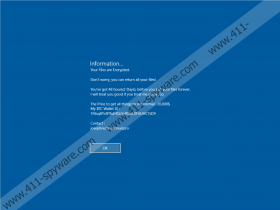Josephnull Ransomware Removal Guide
You must not take the demands introduced by Josephnull Ransomware seriously because the attackers behind this infection are after your money, and they are willing to tell you anything to get it. Just like most other file-encrypting threats, it promises victims a decryptor in return for money, but this promise cannot be trusted. If you give cybercriminals your money, they will take it, and you will not be able to get it back. Unfortunately, whether or not you get a decryptor in return is the business of attackers, and if you assume that they would do the right thing, you are sadly mistaken. At this point, even the authorities cannot force cybercriminals to make a fair exchange. So, have you paid the ransom already? Or are you currently trying to understand the infection better? In any case, we have information about the threat and its removal. If you want to delete Josephnull Ransomware as soon as possible, know that this malware should eliminate itself, with only a few components staying behind.
If you remember opening a spam email attachment or downloading a new file or program onto your computer right before the malicious Josephnull Ransomware got in, it is likely that you can trace the attack back to the beginning. If you have no idea how malware slithered in, you have to assume that other threats might have done the same. Install a trusted malware scanner to help you perform a full system scan, if you have not done that already. In general, it is possible that you cannot pinpoint the exact moment that Josephnull Ransomware got in because it does that silently. Obviously, if security software exists, it should catch and remove the infection before it executes. However, if safeguards do not exist, this malware can invade your system and encrypt your personal files silently. According to our research team, this malware targets very specific files. Some of them include .MP4, .RAW, .PNG, .ZIP, .JAVA, .PDF, .JPG, or .DOC files. Without a doubt, it is most detrimental to have personal files encrypted, because those might be impossible to replace. After encryption, the “.crypted” extension must be added to the original names, and the infection must delete itself.
One file that Josephnull Ransomware – which is a new Hakbit Ransomware variant – leaves behind is called “HOW_TO_DECYPHER_FILES.hta,” and you should find it on the Desktop. The file carries a message, according to which the attacker could have wiped all data but chose to only encrypt files. Now they offer you the opportunity to restore the files by paying a ransom of 20,000$ in Bitcoin to 1F6sq8YvftTfuE4QcYxfK8s5XFUUHC7sD9. At the time of research, this Bitcoin Wallet was empty, but that could change at any point. The ransom note also lists two email addresses – my-contact-email@protonmail.com and josephnull@secmail.pro– that victims can use to contact the attackers behind Josephnull Ransomware. If you do not want to expose yourself to cybercriminals, we suggest refraining from doing that. Paying the ransom, as we have explained already, is not something we can stand by either. We hope that you are not trapped by ransomware because you have copies of all personal files stored somewhere safe, and now you can replace the corrupted files with these copies.
Whether you can replace the corrupted files, or you have to count your losses, you must remove Josephnull Ransomware first. Yes, it should remove itself automatically, but as we have seen, a few components are left behind. One of them is the ransom note file. Another one can be found in the registry, where the infection adds another version of a ransom note to open after restart. These components are very easy to delete, and you might be able to handle the task manually. However, the elimination of a malicious file-encryptor is not the only thing you need to figure out. It is also important to secure the operating system, and that is easy to do with the right tool. Anti-malware software can offer a full safeguard system against malware, and it also can delete Josephnull Ransomware automatically. Of course, to ensure the security of personal files, you must not forget to create backups and to store them safely.
How to delete Josephnull Ransomware
- Delete the HOW_TO_DECYPHER_FILES.hta file from the Desktop.
- Launch File Explorer by tapping Win+E keys and enter %TEMP% into the field at the top.
- Delete a malicious {random name}.exe file that belongs to the ransomware.
- Launch Run by tapping Win+R keys and enter regedit into the dialog box.
- In Registry Editor, move to HKLM\SOFTWARE\Microsoft\Windows NT\CurrentVersion\Winlogon.
- Delete the value named LegalNoticeCaption and a value named LegalNoticeText.
- Empty Recycle Bin once you think that all malicious components are gone.
- Install a trusted malware scanner and examine your system for leftovers with a full system scan.
Josephnull Ransomware Screenshots:




